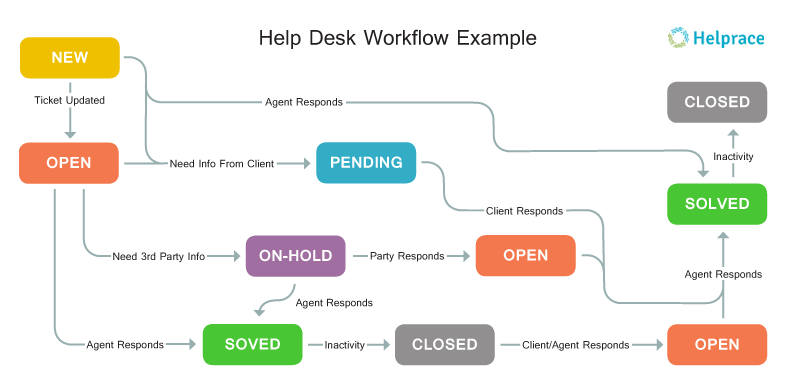-
How to Collaborate Better: The Case for a Team Help Desk
Thu, 10 Jan 2019, in Teams
Enjoying this post? You might also like 10 Reasons for Customer Segmentation in Customer Service

Every single individual within an organization (including your various teams, departments and clients) matter. That’s a lot for a manager to tackle! Therefore, how collaboration is managed in an organization impacts innovation, growth, and ultimately, its success.
Every organization approaches this problem differently. Some prioritize “customer-first” or “people-first” type of communication, while others chalk it down to management traits or organizational structures that help dictate the direction they pursue.
Where do you begin?
- Determine your organizational team philosophy
- Identify, organize and restrict team content
- Route tickets according to expertise
How you capture, store and organize your information matters a great deal, too. Ultimately, you juggle maintaining these relationships with promoting your organization’s goals – though your product, marketing, philosophy, and so forth.
Proper help desk software lets you manage conversations with adequate segmentation, automation, analytics, and the like. Help desk software make support and internal communication easy without expensive implementation costs or administrative investments for the business.
Step 1: Determine your organizational team philosophy
Most aspiring leaders have a passion or goal for building a great team. A team, which, as a whole is considered a leader in its sphere and in status. Besides, who would want to run an “okay” or mediocre team?
Read More: 15 Secrets of Leading Customer Service Departments
Of course, the best teams need the best environment to thrive. There needs to be process and system built in that facilitates individual as well as team success within an organization.
Some organizations might be structured to have a “leader- team” mentality. Others have an authority-team mentality. Still others may set up a network of teams not beholden to anyone, except, perhaps, to the CEO. Here are some examples of operational philosophies within businesses:
“Relationship builders” These companies believe that understanding customers (as well as team members) inherently places them in a good position for reacting to these needs in a timely manner. Their main challenge is implementing cultural changes at scale without harming the relationships they’ve built.
“Complexity masters” Due to the nature (and size) of these operations, complexity of support requests and likely a hierarchical business structure, change, while welcome, is never implemented. Their system has already been optimized to capacity, so there’s little that can be done to drive organizational change.
“Change drivers” These companies may be large or small, but what sets them apart is how open they are to change and progress. Yet, their main challenge is a lack of resources. Too much focus on sales, marketing or product development makes it difficult to prioritize and execute changes.
Teams of all types can be difficult to manage, especially as the number of people and their duties increase. That’s why examining your organizational structure should be a crucial component of any team philosophy.
Step 2: Identify, organize and restrict team content
While you might have established leadership and a hierarchical structure for your teams, how will they interact between each other? Information must move horizontally, and managing siloed data structures is often the first of the roadblocks.
Read More: Glorious Support with Teams, Groups & Organizations
Coming up with your structure will be the hard part. How much responsibility or authority do you want to give one team vs another? Is there confidential information you’d rather keep away from prying eyes?
By organizing your support staff into teams, you’re able to better maintain the needed information to maintain customer satisfaction. There are virtually countless ways to manage your team structure and all that depends on your business type, customer type and a lot more.
Request Management
- Separate responsibility for requests
e.g. if you want to always assign billing and refund related emails to the Billing team. - Restrict access to confidential requests
e.g. if you want to ensure that no one except certain billing agents see tickets meant for the Billing team. - Escalate requests according to complexity
e.g. if you want Team 1 and Team 2 to only see their own tickets, while Team 3 agents can see tickets from Team 1, 2, 3.
Team Management
- Assign a team to particular mailbox
e.g. if you want to ensure that emails to billing@acme.com are addressed by the Billing team. - Divide up teams according to expertise
e.g. if you have a Support team and Product team can share an agent with expertise in both areas. - Assign requests to a team based on tags
e.g. if you want tickets with the word refund in the subject or body to get tagged “refund” and are assigned to the Billing team. - Divide support by time zone or language
e.g. if you have a Team 1 is for supporting English-speaking customers on the east coast and the Team 2 is for supporting Spanish-speaking customers on the west coast.
Content Management
- FAQ page for Billing & Refund staff
e.g. a questions and answers page for top management and those that issue billing & refunds. - Knowledge base for different teams
e.g. a knowledge base for staff from Team 1, 2, 3 to share tips, hints and articles. - Issue tracking for a specific team
e.g. a problem tracking page for product development staff to report internal issues. - Idea gathering site for staff
e.g. an idea and suggestion gathering page for staff members.
Step 3: Route tickets according to expertise
Whether your team is large or small, streamlining the way tickets behave according to your levels of complexity, teams, departments.
Helprace is built on the assumption that everyone should be able to assign a request to anyone else. Therefore, support requests can be visible by all, and not visible by all once assigned to a team or team member. As another alternative, you can hide a request from everyone but the most qualified representatives.

This makes it particularly easy to separate requests based on what they’re about. Billing? Technical support? Marketing offers? On the other side of the helpdesk, you can group requests to teams according to seniority, expertise or similar.
We built Helprace on the assumption that a support representative can answer any ticket that comes in to the help desk. If not, they can assign it to a more specialized team member. Therefore, as you set up your help desk, you can ensure a particular type of request stays hidden from all except a few qualified support representatives.
Read More: Top 15 Ways to Scale Your Support
At the same time, cross-departmental assignment is always there. This allows lesser skilled reps to improve their skills, collaborate or maintain input into a certain ticket. Another scenario is for support staff to assign tickets among support staff within a team as well as across teams. Lastly, auto-assignment options within a team allows the help desk system to operate behind the scenes. This is something that may be desirable in a large organization.
Match your team with the right desk

Internal service desk An internal ticketing system is designed specifically for company-wide communication. An internal knowledge base could also be part of this, as well as integrations with a service desk or other project management tools.

External service desk Teams that need to communicate with a user base are known as being “external”. Service and support issues come from individuals or end-users seeking assistance from the organization.
What makes Helprace an ideal collaboration tool?
It’s not always easy to pinpoint what type of software will revolutionize team communication and make all your collaboration worries disappear. Sometimes it pays to understand the underlying reason why a certain software is created and what problem areas it addresses.

Ultimately, the customer experience stars and ends with what you, as a company can offer in terms of communication options. A great way to show your customers that you “care” is by being there for them when they least expect it. And that’s a lot easier to do with a team help desk.
First, it’s a ticketing system that’s designed to be personal. Fully integrated with email, there are multiple inboxes, email addresses, productivity and organizational features. Delve deep with a number of typical ticketing system metrics: Tickets, Productivity, Team, or Happiness. They all keep track of what’s going on in your support system.
In addition, there’s a knowledge base and a host of other customer service tools that encourage site visitors (and fence-sitters) to speak their mind. A community complete with questions, answers or issue sharing for those wishing to participate in conversations. The point here is to give customers many options.
Still have questions?
Read More: What Is Help Desk Software Anyway? Helpdesk Explained
Tags: teams


